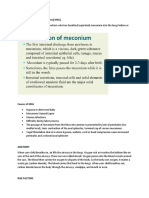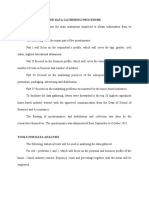Respiratory Distress Syndrome
Respiratory Distress Syndrome
Uploaded by
Wiljohn de la CruzCopyright:
Available Formats
Respiratory Distress Syndrome
Respiratory Distress Syndrome
Uploaded by
Wiljohn de la CruzOriginal Description:
Original Title
Copyright
Available Formats
Share this document
Did you find this document useful?
Is this content inappropriate?
Copyright:
Available Formats
Respiratory Distress Syndrome
Respiratory Distress Syndrome
Uploaded by
Wiljohn de la CruzCopyright:
Available Formats
Etiology
Type two alveolar cells produce surfactant and do not develop until the 25th to the 28th week of
gestation, in this, respiratory distress syndrome is one of the most common respiratory disease in
premature infants. Furthermore, surfactant deficiency and pulmonary immaturity together leads
to alveolar collapse. Predisposing factors that contribute to poorly functioning type II alveolar
cells in a premature baby are if the child is a preterm male, white infants, infants of mothers with
diabetes, precipitous deliveries, cesarean section performed before the 38th week of gestation.
Surfactant synthesis is influenced by hormones, this ranges form insulin and cortisol. Insulin
inhibits surfactant production, explaining why infants of mothers with diabetes type 1 are at risk
of development of respiratory distress syndrome. Cortisol can speed up maturation of type II
cells and therefore production of surfactant. Finally, in the baby delivered by cesarean section are
at greater risk of developing respiratory distress syndrome because the reduction of cortisol
produced because the lack of stress that happens during vaginal delivery, hence cortisol increases
in high stress and helps in the maturation of type II cells of the alveoli that cause surfactant.
Respiratory Distress Syndrome
Pathophysiology
At birth the pressure needed to expand the lungs requires high inspiratory pressure. In the
presence of normal surfactant levels the lungs retain as much as 40% of the residual volume after
the first breath and thereafter will only require far lower inspiratory pressures. In the case of
deficiency of surfactant the lungs will collapse between breaths, this makes the infant work hard
and each breath is as hard as the first breath. If this goes on further the pulmonary capillary
membranes become more permeable, letting in fibrin rich fluids between the alveolar spaces and
in turn forms a hyaline membrane. The hyaline membrane is a barrier to gas exchange, this
hyaline membrane then causes hypoxemia and carbon dioxide retention that in turn will further
impair surfactant production.
Treatment
Today to prevent respiratory distress syndrome are animal sources and synthetic surfactants, and
administrated through the airways by an endotracheal tube and the surfactant is suspended in a
saline solution. Treatment is initiated post birth and in infants who are at high risk for respiratory
distress syndrome.
You might also like
- GROUP 6C BIOCHEMISTRY LAB Final OutputDocument9 pagesGROUP 6C BIOCHEMISTRY LAB Final OutputJudi Clarisse Bagano PaderesNo ratings yet
- Case Study TBDocument9 pagesCase Study TBCheche_Guinto_8235100% (2)
- Respiratory Distress in NewbornDocument7 pagesRespiratory Distress in NewbornChimot Ona MilanelloNo ratings yet
- Infant RDSDocument3 pagesInfant RDSVenice Ramiro GamutanNo ratings yet
- 1) Respiratory Distress Syndrome (RDS) Hyaline Membrane Disease (HMD)Document9 pages1) Respiratory Distress Syndrome (RDS) Hyaline Membrane Disease (HMD)ُEssraa AdeelNo ratings yet
- Acute Conditions of The NewbornDocument46 pagesAcute Conditions of The NewbornCamille Joy BaliliNo ratings yet
- Idiopathic Respiratory Disease SyndromeDocument30 pagesIdiopathic Respiratory Disease SyndromeAllan-VonNo ratings yet
- Transient TachypneaDocument3 pagesTransient TachypneaChristopher Balictar HilisNo ratings yet
- 4 Respiratory Distress Syndrome in The NewbornDocument3 pages4 Respiratory Distress Syndrome in The NewbornChristine Danica BiteraNo ratings yet
- Meconium Aspiration SyndromeDocument11 pagesMeconium Aspiration SyndromeFerreze AnnNo ratings yet
- Meconium Aspiration SyndromeDocument13 pagesMeconium Aspiration SyndromeJhing Rodriguez Borjal100% (1)
- RDS Ppts 2021Document37 pagesRDS Ppts 2021Mohammad NajjarNo ratings yet
- Congenital AnomaliesDocument22 pagesCongenital Anomaliesjessy100% (1)
- Rad AnDocument5 pagesRad AnHenry Salvador ParzaNo ratings yet
- RESPIRATORY DIS-WPS OfficeDocument12 pagesRESPIRATORY DIS-WPS OfficeGiselle EstoquiaNo ratings yet
- Meconium Aspiration Syndrome (Daran, Maria Ranela)Document8 pagesMeconium Aspiration Syndrome (Daran, Maria Ranela)Carlojay IniegoNo ratings yet
- Respiratory Distress SyndromeDocument46 pagesRespiratory Distress SyndromegregNo ratings yet
- Hyaline Membrane Disease/ Respiratory Distress SyndromeDocument28 pagesHyaline Membrane Disease/ Respiratory Distress SyndromeElvis JinjikaNo ratings yet
- Pediatrics Specific DisordersDocument6 pagesPediatrics Specific DisorderssitalcoolkNo ratings yet
- Case StudyDocument5 pagesCase StudyJui Perano100% (2)
- Respiratory Distress Sydrome Year 5-2Document36 pagesRespiratory Distress Sydrome Year 5-2chebetnaomi945No ratings yet
- CASE 1: Manipac Yao: Cmmatias (Cmed 2022)Document3 pagesCASE 1: Manipac Yao: Cmmatias (Cmed 2022)Charm MatiasNo ratings yet
- Illness in The NewbornDocument34 pagesIllness in The NewbornVivian Jean TapayaNo ratings yet
- Meconium Aspiration SyndromeDocument12 pagesMeconium Aspiration SyndromeJonielyn LagunaNo ratings yet
- Pediatrics Exposition.: Pulmonary Respiratory Pathology in Preterm Infants (Under 37 Weeks of Gestation)Document2 pagesPediatrics Exposition.: Pulmonary Respiratory Pathology in Preterm Infants (Under 37 Weeks of Gestation)David Rodríguez GarcíaNo ratings yet
- Case Study OligoDocument7 pagesCase Study OligomutiaNo ratings yet
- Meconium Aspiration SyndromeDocument2 pagesMeconium Aspiration SyndromeDane Marie BalbiranNo ratings yet
- Meconium Aspiration SyndromeDocument12 pagesMeconium Aspiration Syndromehoneysharlotte_634889% (9)
- Preterm / Premature Labor: EtiologyDocument8 pagesPreterm / Premature Labor: EtiologyCheney BalbuenaNo ratings yet
- Iadt04i5p333 PDFDocument7 pagesIadt04i5p333 PDFBilly UntuNo ratings yet
- Tracheoesophageal Fisture - OutDocument7 pagesTracheoesophageal Fisture - OutZoe Jeanne GarcianoNo ratings yet
- Neonatal Respiratory Care: Moderated By: Shyam Krishnan Presented By: A Sampath KumarDocument62 pagesNeonatal Respiratory Care: Moderated By: Shyam Krishnan Presented By: A Sampath KumarPrethy PhilipNo ratings yet
- Intrauterine Hypoxia. Asphyxia of A NewbornDocument7 pagesIntrauterine Hypoxia. Asphyxia of A NewbornMuhammed ElnakibNo ratings yet
- Paeds ProtocolDocument44 pagesPaeds ProtocolDesmond LingNo ratings yet
- Obs Gynae Presentation by Roll No 127Document23 pagesObs Gynae Presentation by Roll No 127Siddharth KatyalNo ratings yet
- CHN Concept MapDocument9 pagesCHN Concept Maprosemaria9672No ratings yet
- Transient Tachypnea of The Newborn OutlineDocument7 pagesTransient Tachypnea of The Newborn OutlineMarceline GarciaNo ratings yet
- Respiratory Distress SyndromeDocument121 pagesRespiratory Distress Syndromeinno so qtNo ratings yet
- Focus: Gestational AgeDocument82 pagesFocus: Gestational AgeVincent Jofette AventunaNo ratings yet
- NT Apr09Document12 pagesNT Apr09Erick SuxeNo ratings yet
- Respiratory Distress Syndrome: NewbornDocument17 pagesRespiratory Distress Syndrome: NewbornLoloNo ratings yet
- Respiratory Distress Syndrome in NewbornDocument24 pagesRespiratory Distress Syndrome in NewbornDrRajneesh Shastri100% (1)
- Transient Tachypnea of The Newborn: BackgroundDocument9 pagesTransient Tachypnea of The Newborn: BackgroundAnnisa YusufNo ratings yet
- Respiratory Distress SyndromeDocument30 pagesRespiratory Distress SyndromeDennis MiritiNo ratings yet
- Meconium AspirationDocument7 pagesMeconium AspirationDelphy VargheseNo ratings yet
- Chronic Lung Disease in InfantsDocument10 pagesChronic Lung Disease in InfantsMuhammad FauziNo ratings yet
- Respiratory Distress Syndrome (Iniego Carlo Jay)Document9 pagesRespiratory Distress Syndrome (Iniego Carlo Jay)Carlojay IniegoNo ratings yet
- Respiratory Distress Syndrome & PrematureDocument48 pagesRespiratory Distress Syndrome & PrematureDivieya Tharisini KrisnanNo ratings yet
- Mecocium Aspiration SyndromeDocument13 pagesMecocium Aspiration SyndromeSANANo ratings yet
- JmkyutisafuDocument6 pagesJmkyutisafuKatrina EstoconingNo ratings yet
- Physiological Characteristics of NewbornDocument11 pagesPhysiological Characteristics of Newbornbhawna75% (4)
- Meconium Aspiration Syndrom1Document3 pagesMeconium Aspiration Syndrom1Nikael Patun-ogNo ratings yet
- Icn Complications 2Document42 pagesIcn Complications 2sallykamareddineNo ratings yet
- What Is Meco-WPS OfficeDocument6 pagesWhat Is Meco-WPS OfficefadegsyaNo ratings yet
- Homework PreemiDocument8 pagesHomework PreemiTeenie Guerrero-GarciaNo ratings yet
- Neonatal ResuscitationDocument15 pagesNeonatal ResuscitationAmruta GadeNo ratings yet
- NRP Book 27 12 2022Document89 pagesNRP Book 27 12 2022somabiswas488No ratings yet
- Illness in NewbornDocument2 pagesIllness in Newbornitsjamyca najorraNo ratings yet
- Neonatal and Pediatric Respiratory Care for Healthcare ProvidersFrom EverandNeonatal and Pediatric Respiratory Care for Healthcare ProvidersNo ratings yet
- Family Structure: Family Is A Group of People orDocument24 pagesFamily Structure: Family Is A Group of People orWiljohn de la CruzNo ratings yet
- Childhood DisordersDocument4 pagesChildhood DisordersWiljohn de la CruzNo ratings yet
- Great Man TheoriesDocument9 pagesGreat Man TheoriesWiljohn de la CruzNo ratings yet
- Instrumentation and Data Gathering ProcedureDocument3 pagesInstrumentation and Data Gathering ProcedureWiljohn de la CruzNo ratings yet
- Bullets For CHNDocument4 pagesBullets For CHNWiljohn de la CruzNo ratings yet
- Sections & Statements: Physical: OrangeDocument2 pagesSections & Statements: Physical: OrangeWiljohn de la CruzNo ratings yet
- Awareness TyphoonsDocument5 pagesAwareness TyphoonsWiljohn de la CruzNo ratings yet
- Balance Wheel Vs JuvenileDocument17 pagesBalance Wheel Vs JuvenileWiljohn de la CruzNo ratings yet
- Your Plan: RememberDocument4 pagesYour Plan: RememberWiljohn de la CruzNo ratings yet
- An Introduction To Teen Issues: by Karen AdamsDocument4 pagesAn Introduction To Teen Issues: by Karen AdamsWiljohn de la CruzNo ratings yet
- Your Plan: CaliforniaDocument4 pagesYour Plan: CaliforniaWiljohn de la CruzNo ratings yet
- Anatomy and PhysiologyDocument2 pagesAnatomy and PhysiologyWiljohn de la CruzNo ratings yet
- Taiping Island Exclusive Economic ZoneDocument1 pageTaiping Island Exclusive Economic ZoneWiljohn de la CruzNo ratings yet
- Urinary Tract Infections (Utis) in Children Are Fairly Common, But Not Usually Serious. They Can Be Effectively Treated With AntibioticsDocument2 pagesUrinary Tract Infections (Utis) in Children Are Fairly Common, But Not Usually Serious. They Can Be Effectively Treated With AntibioticsWiljohn de la CruzNo ratings yet
- Cerebral Hemisphere Is Divided Into LobesDocument2 pagesCerebral Hemisphere Is Divided Into LobesWiljohn de la CruzNo ratings yet
- TEEN PREGNANCY - An IntroductionDocument2 pagesTEEN PREGNANCY - An IntroductionWiljohn de la CruzNo ratings yet
- By Karen Adams: Teens Want To Know That Parents Are On Their SideDocument2 pagesBy Karen Adams: Teens Want To Know That Parents Are On Their SideWiljohn de la CruzNo ratings yet
- Organs and Structures of The Respiratory SystemDocument2 pagesOrgans and Structures of The Respiratory SystemWiljohn de la CruzNo ratings yet
- Accountability 2. Just LawsDocument2 pagesAccountability 2. Just LawsWiljohn de la CruzNo ratings yet
- 5 Minutes: A City of CellsDocument7 pages5 Minutes: A City of CellsWiljohn de la CruzNo ratings yet
- Issues About TeenDocument2 pagesIssues About TeenWiljohn de la CruzNo ratings yet
- Health andDocument57 pagesHealth andWiljohn de la CruzNo ratings yet
- Sample Title: Integration Paper For Philosophy of Values and EthicsDocument3 pagesSample Title: Integration Paper For Philosophy of Values and EthicsWiljohn de la CruzNo ratings yet


















































































